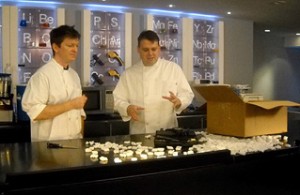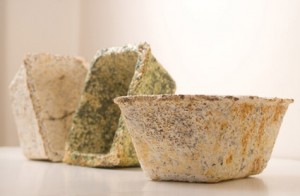Edible Packaging
Overflowing landfills are a huge problem in the U.S. and worldwide. Scientists may have discovered an innovative way to dispose of much of the plastic, but a lot of trash still remains.
Everything we buy usually comes packaged in some form of non-biodegradable padding or casing, including boxes, bags, wrappers, and foam. We throw it away without even thinking about it, but trash from packaging is adding up. By weight, 50% of all of the trash in the United States is from packaging. The average American throws away their own weight in packaging every 30-40 days! Some of the smarter people in the world have begun to take notice, and are doing some big things about it.
Dr. David Edwards at Harvard University has developed several types of edible membrane that can encapsulate a number of different types of food, both liquid and solid. The membranes are composed of a combination of polymers (large molecules composed of repeating structural units) and food particles, and Dr. Edwards is calling the project ‘WikiCells.’ His inspiration came from studying natures natural carrying cases, such as grapes and tomatoes.
Restaurants are the initial target market, but the future applications could be infinite. Dr. Edwards believes we could see the idea on supermarket shelves within 12 months. Future applications could include a juice box made of an edible orange membrane, apple sauce encapsulated in a solid made of apple particles, or hot chocolate wrapped in a delicious edible shell. Dr. Edwards believes that, “We are revolutionizing the delivery system of nutrients, vitamins and supplements.”
Professor John Krochta at the University of California has been tinkering with a similar invention. His goal is to reduce our dependence on plastics, as well as to make many types of food spoil proof. The design will be tamper-proof to protect against predators, as well as business friendly; able to include a logo, while not compromising the structure of the food item.
Finally, New York based company Ecovative Design has expanded the edible packaging realm to encompass things far greater than just foods. Founders and mechanical engineers Eben Bayer and Gavin McIntyre are growing mushroom blocks that are being used to cushion electronics and furniture during their transportation to and from retail outlets.
This amazing innovation is replacing plastic packing foams which previously have been known to take thousands of years to biodegrade. They are actually growing mushroom cushions in the exact shapes needed to support specific projects. The vegetative part of the mushroom called mycelium grows millions of strands that is then heat dried so that further mushrooms cannot grow from it. The resulting packaging is anti-allergenic, edible, and incredible.
Major issues that may arise from edible packaging certainly include sanitation. With Dr. Edwards’ design, if the entire exterior is edible, how do we ensure that it is not improperly handed by store employees and customers alike? A major benefit of edible packaging is that it is always biodegradable; so eat it or not, it can safely be disposed of, or even fed to your dog! Another issue that may arise is how these various membranes will react to different temperatures and climates. Will extreme cold or heat or an increase in humidity have an adverse effect on the final product?
Intrigued? Want to sample some edible packaging for yourself? Visit Dr. Edwards’ site here.
Comments
Tags: David Edwards, Eben Bayer, Ecovative Design, edible packaging, Gavin McINtyre, John Krochta, lab store paris, membranes, mycelium, WikiCells
Trackback from your site.



Comments (1)
Maven
| #
This is intriguing but I cant get past the idea that the casing is exposed. If I can feed the packaging to my dog, now that would be ideal.
Reply